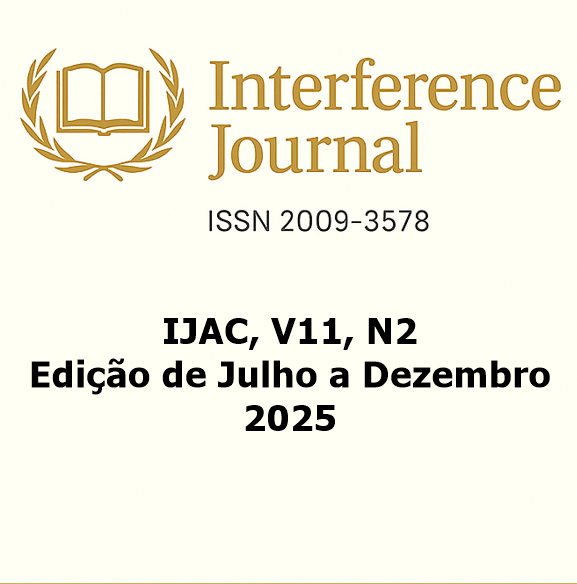Post-Traumatic Facial Asymmetries: Challenges in Three-Dimensional Diagnosis and Surgical Correction Strategies
DOI:
https://doi.org/10.36557/2009-3578.2025v11n2p1134-1145Keywords:
facial asymmetry; maxillofacial surgery; imaging diagnosis; cone-beam computed tomography; surgical planning.Abstract
Post-traumatic facial asymmetries represent a relevant clinical challenge due to the anatomical complexity involved and the limitations of conventional diagnostic methods. With the advancement of three-dimensional technologies such as cone-beam computed tomography (CBCT), surgical simulation software, and personalized 3D-printed guides, it has become possible to perform more precise morphological evaluations, contributing to more efficient surgical planning. Recent studies demonstrate that the use of virtual planning and customized devices significantly improves accuracy in correcting asymmetries, especially in cases involving the lower third of the face, mandibular angle, and chin deviations. Furthermore, soft tissue–driven approaches have been integrated into bone planning, allowing for superior aesthetic predictability. Techniques such as guided osteotomy, use of patient-specific implants (PSIs), and planning assisted by artificial intelligence have been successfully described in the correction of residual and postoperative deformities. The literature emphasizes the importance of accurate diagnosis based on digital symmetry and volumetric analysis, highlighting the need for individualized therapeutic strategies. Thus, the integration of three-dimensional tools and detailed surgical planning represents an evolution in the management of patients with post-traumatic facial asymmetry, providing better functional and aesthetic outcomes.
Downloads
References
ALLGAYER, S.; MEZZOMO, F. S.; POLIDO, W. D.; ROSENBACH, G.; TAVARES, C. A. E. Tratamento ortodôntico-cirúrgico da assimetria facial esquelética: relato de caso. Dental Press Journal of Orthodontics, 2025. Disponível em: https://www.scielo.br/j/dpjo/a/DcybwNYRHBxpf6XnWs3Krcq/. Acesso em: 4 ago. 2025.
CHENG, Z.; GUAN, Z.; ZHANG, Y. Management of facial asymmetry assisted with digitally designed surgical guide for 3-dimensional maxillary repositioning: A case report. American Journal of Orthodontics and Dentofacial Orthopedics, 2024. Disponível em: https://pubmed.ncbi.nlm.nih.gov/39671823/. Acesso em: 4 ago. 2025.
DUAN, H. et al. Correcting facial asymmetry through guided plate assisted mandibular angle osteotomy. Frontiers in Surgery, v. 11, 2024. Disponível em: https://www.frontiersin.org/articles/10.3389/fsurg.2024.1391231/full. Acesso em: 4 ago. 2025.
GAO, Y. et al. Soft‑tissue driven craniomaxillofacial surgical planning. arXiv preprint, 2023. Disponível em: https://arxiv.org/abs/2307.10954. Acesso em: 4 ago. 2025.
HUANG, J. et al. Three-dimensional assessment of facial asymmetry in Class III subjects with mandibular deviation: evaluating postsurgical outcomes. American Journal of Orthodontics and Dentofacial Orthopedics, v. 161, n. 4, p. 553–562, 2022. Disponível em: https://pubmed.ncbi.nlm.nih.gov/35320382/. Acesso em: 4 ago. 2025.
KAMIJŌ, H. et al. Evaluation of mandibular asymmetry using cone-beam computed tomography and surgical planning in facial trauma. Journal of Cranio-Maxillofacial Surgery, v. 51, n. 1, p. 65–72, 2023. Disponível em: https://pubmed.ncbi.nlm.nih.gov/36599971/. Acesso em: 4 ago. 2025.
KIM, Y. H. et al. Three-dimensional surgical simulation improves the planning for correction of facial prognathism and asymmetry. Journal of Cranio-Maxillofacial Surgery, v. 45, n. 1, p. 39–47, 2017. Disponível em: https://pubmed.ncbi.nlm.nih.gov/28071714/. Acesso em: 4 ago. 2025.
KIM, Y. J. et al. Three-dimensional digital planning and printing for surgical correction of post-traumatic facial deformities. Journal of Oral and Maxillofacial Surgery, v. 81, n. 4, p. 702–710, 2023. Disponível em: https://pubmed.ncbi.nlm.nih.gov/36642393/. Acesso em: 4 ago. 2025.
KO, E. W. et al. Precision and efficacy of digital technology in orthognathic surgery for facial asymmetry correction. Aesthetic Plastic Surgery, 2025. Disponível em: https://link.springer.com/article/10.1007/s00266-025-04974-x. Acesso em: 4 ago. 2025.
LIU, Y. et al. Changes in facial symmetry following computer-assisted secondary correction of craniofacial fractures. Journal of Oral and Maxillofacial Surgery, 2023. Disponível em: https://pubmed.ncbi.nlm.nih.gov/37427923/. Acesso em: 4 ago. 2025.
MUKAI, N. et al. Surgical planning and 3D modeling for reconstruction of post-traumatic facial deformities. International Journal of Oral and Maxillofacial Surgery, v. 52, n. 4, p. 513–520, 2023. Disponível em: https://pubmed.ncbi.nlm.nih.gov/36848922/. Acesso em: 4 ago. 2025.
ONIĆA, A. I. et al. The role of soft tissue simulation in orthognathic surgery: A 3D comparative study. Journal of Clinical Medicine, v. 12, n. 9, p. 3141, 2023. Disponível em: https://www.mdpi.com/2077-0383/12/9/3141. Acesso em: 4 ago. 2025.
PARK, J. H. et al. Virtual surgical planning and patient-specific implants in the treatment of complex facial asymmetry: A prospective study. Plastic and Reconstructive Surgery, v. 149, n. 5, p. 1037e‑1046e, 2022. Disponível em: https://journals.lww.com/plasreconsurg/Fulltext/2022/05000/Virtual_Surgical_Planning_and_Patient_Specific.31.aspx. Acesso em: 4 ago. 2025.
TURNER, B. R. et al. Computer‑aided design and manufacturing of patient‑specific implants for the correction of post‑traumatic facial deformities. Journal of Craniofacial Surgery, v. 36, n. 2, p. 387–394, 2025. Disponível em: https://journals.lww.com/jcraniofacialsurgery/fulltext/2025/36020/computer_aided_design_and_manufacturing_of.31.aspx. Acesso em: 4 ago. 2025.
VILLALBA, M. et al. Accuracy of 3D‑printed surgical guides in the correction of facial asymmetries: A clinical study. Journal of Stomatology, Oral and Maxillofacial Surgery, v. 123, n. 6, p. 587–593, 2022. Disponível em: https://www.sciencedirect.com/science/article/pii/S2468785522001014. Acesso em: 4 ago. 2025.
ZHU, W. et al. A review of three‑dimensional facial asymmetry analysis methods. Symmetry, v. 14, n. 7, p. 1414, 2022. Disponível em: https://www.mdpi.com/2073-8994/14/7/1414. Acesso em: 4 ago. 2025.
Downloads
Published
How to Cite
Issue
Section
License
Copyright (c) 2025 Maria Josilaine das Neves de Carvalho, Belmino Carlos Amaral Torres, Marcos Gustavo Oliveira da Silva, Amanda de Figueiroa Silva, Felipe Garcia Heiderich Segundo, Jeyse Anne Vasconcelos da Silva, Josie Meneses Aguiar, Maria Vitória Bezerra Cavalcanti, Pedro Alves de Almeida, Túlio Rodrigues Valença

This work is licensed under a Creative Commons Attribution 4.0 International License.
Você tem o direito de:
- Compartilhar — copiar e redistribuir o material em qualquer suporte ou formato para qualquer fim, mesmo que comercial.
- Adaptar — remixar, transformar, e criar a partir do material para qualquer fim, mesmo que comercial.
De acordo com os termos seguintes:
- Atribuição — Você deve dar o crédito apropriado , prover um link para a licença e indicar se mudanças foram feitas . Você deve fazê-lo em qualquer circunstância razoável, mas de nenhuma maneira que sugira que o licenciante apoia você ou o seu uso.
- Sem restrições adicionais — Você não pode aplicar termos jurídicos ou medidas de caráter tecnológico que restrinjam legalmente outros de fazerem algo que a licença permita.


